|
Synonyms:
|
Periophthalmus chrysospilos |
Bleeker, 1852 |
(senior synonym, original combination) |
Etymology:
'Periophthalmus' is a compound name from the Greek 'peri' (around), and 'ophthalmôn' (eye), which refers to the wide
visual field of these species
'chrysospilos' probably comes from 'chrusos' (gold), and 'spilos' (stone), (= gold nugget?), which
refers to the yellow speckles on head and flanks
|
Maximum recorded length:
100 mm TL (Polgar & Bartolino, 2010)
Live colouration
(Murdy, 1989, pers. obs.: Peninsular Malaysia):
ground colour pale to dark grey; head and trunk with numerous orange speckles larger than the underlaying scales, also ventrally on
gill cover, prepelvic area, and chin; dorsal dusky saddle-like bars may be visible; D1 membrane anteriorly dusky, medially and proximally
red, posteriorly and inframarginally black, and with a thin translucent margin; D2 with a distal reddish margin, a black stripe medially,
and proximally translucent with a series of dark spots on membrane; caudal fin dusky, distally paler; anal fin transparent; pectoral fins dusky;
pelvic fins white
Colouration on preservation
(Murdy, 1989; pers. obs.: Peninsular Malaysia, Thailand, Indonesia):
ground colour dorsally and laterally grey to tan brown, ventrally whitish to yellowish; sometimes whitish speckles are visible on throat
and opercula; banded pattern rarely observable in the posterior part of body; D1 markedly heterogeneous in colour, posteriorly blackened;
D2 with dark to dusky medial stripe and proximal series of dusky spots, transparent for the rest; caudal and pectoral fins dusky; pelvic
fins whitish to yellowish
Diagnosis (Murdy,
1989):
D1 VII-X; total D2 elements 12-13; total anal fin elements 11-13; TRDB 15-19; longitudinal scale count 64-77; head width 12.6-21.8%SL; pelvic fin
length 12.4-16.8%SL; length of anal fin base 16.7-20.6%SL; length of D2 base 16.3-24.3%SL; pelvic fins totally fused in a disc, pelvic frenum
conspicous; dorsal fins not connected by membrane; no stripes or spots on D1; species-specific sexual dimorphism: first two D1 spines elongated in males.
The genus is yet undefined by synapomorphies
Diet:
it seems that this species (Khoo, 1966, quoted by
Lim, 1971) alternates its feeding regimes from totally
herbivorous (diatoms, filamentous algae - pers. obs. - and other plant material), to carnivorous (crustaceans, harpacticoid
copepods, worms, etc.). Moderate to drastic shifts in the feeding regimes were found in other congeneric species (e.g. P. sobrinus=
P. argentilineatus: Colombini et al., 1996;
P. barbarus: King & Udo, 1998), and seem to be
related to different behaviours of sexes during the reproduction, or seasonal changes, respectively
|
Reproduction:
males jump to attract females inside the burrows to spawn (Polunin, 1972, pers. obs.: Peninsular Malaysia).
Sex in this species can be discriminated by observing D1 in adults: the 1st and 2nd spines are elongated in males. Males dig reproductive burrows in front
of the marine fringe of mangrove forests (Macnae, 1968; pers. obs.: Malaysia peninsulare).
middle: a male at the opening of its reproductive burrow
(Photo: G. Polgar, Tg. Piai, peninsular Malaysia, 2006) |
|
|
Ecological notes (Swennen et al., 1995; Takita et al., 1999; Polgar & Crosa, 2009; Polgar & Bartolino, 2010):
locally very abundant on open mudflats at low tide.
At ebb tide P. chrysospilos gathers in small schools of 20-40 individuals which follow the water edge to feed on the mudflat; with the flood tide
the fishes follow the tide in the opposite direction to enter the pioneer mangrove forest, perching on roots and trunks to escape marine predators (Polgar & Crosa, 2009). The distribution of individuals of different size on open mudflats and mangrove pioneer shores during low tide might depend on the size and persistence of tide pools, which in turn depend on the slope of the intertidal zone (Polgar & Bartolino, 2010)
left: a pioneer Avicennia mangrove forest, a typical habitat where P. chrysospilos takes refuge during high tide
(Sementa, peninsular Malaysia)
right: the open mudflat, where these fishes go to feed (Tg. Piai, peninsular Malaysia)
(Photos by G. Polgar, 2006)
|
|
|
|
A: a freshly dead female, note the absence of elongated D1 spines (photo G. Polgar; specimen collected in Kuala Selangor, peninsular Malaysia, 2006);
B: ventral view of the pelvic disc of a specimen attached to the glass of an aquarium (photo G. Polgar, 2006); C: a specimen in aquarium (photo G. Polgar, 2006); D:
an individual on the open mudflat at low tide (photo G. Polgar; Tg. Piai, Peninsular Malaysia, 2007); E, F: schooling individuals following the ebb tide to the mud flat
(photo G. Polgar; Kukup Is., Peninsular Malaysia, 2006); G: perching individuals on prop roots of Rhizophora mucronata at high tide (photo G. Polgar; Tg. Piai, Peninsular Malaysia, 2006);
H:
another shot of perching P. chrysospilos at high tide; note how smaller and larger individuals
remain close to each other while perching (photo G. Polgar; Tg. Piai, Peninsular Malaysia, 2006); I: a perching individual flagging at a mosquito, visible nearby its eye (photo G. Polgar; Kukup Is., Peninsular Malaysia, 2007); J: another shot of schooling individuals at ebb tide (photo G. Polgar; Morib, Peninsular Malaysia, 1996); K: P. chrysospilos perching on a pneumatophore of Avicennia sp.; L: school at ebb tide:
note the homogeneous direction of all individuals (photo K, L:
Yuko Ikebe) - * with permission
|




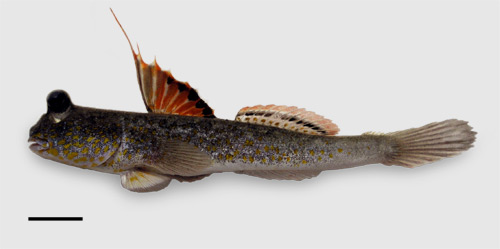
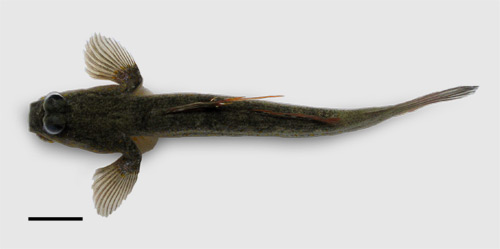
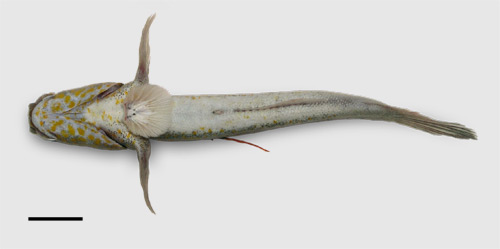
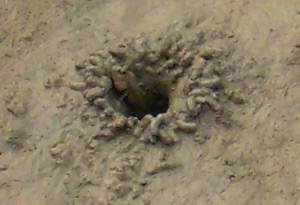
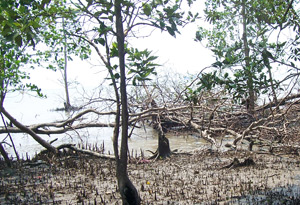
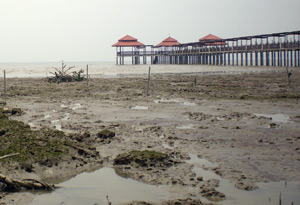
![]()